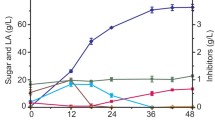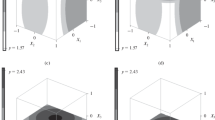Abstract
The fermentability of a corn cob, acid-hydrolysed hemicellulose by Pichia stipitis was considerably improved by pre-treatment with Ca(OH)2. The total sugars utilized and ethanol yield for the untreated hydrolysate were 18% and 0.21 g/g, respectively, compared with 82% and 0.32 g/g respectively for the treated material. Adaptation of the yeast to the hydrolysate resulted in a significantly higher fermentation rate with over 90% of the initial total sugars being utilized and an ethanol yield and maximum ethanol concentration of 0.41 g/g and 13.3 g/l, respectively.
Similar content being viewed by others
References
BeckM.J. 1986 Factors affecting efficiency of biomass fermentation to ethanol. Biotechnology and Bioengineering Symposium 17, 617–627.
ClarkT.A. & MackieK.L. 1984 Fermentation inhibitors in wood hydrolysates derived from soft wood Pinus radiata. Journal of Chemical Technology and Biotechnology 34b, 101–110.
FeinJ.E., TallimS.R. & LawfordG.R. 1984 Evaluation of D-xylose fermenting yeasts for utilization of a wood derived hemicellulose hydrolysate. Canadian Journal of Microbiology 30, 628–690.
HinmanN.D., WrightJ.D., HoaglandW. & WymanC.E. 1989 Xylose fermentation, An economic analysis. Applied Biochemistry and Biotechnology 20/21, 319–401.
JeffriesT.W. 1982 A comparison of Candida tropicalis and Pachysolen tannophilus for conversion of xylose to ethanol. Biotechnology and Bioengineering Symposium 12, 103–110.
JeffriesT.W. 1985 Emerging technology for fermenting xylose. Trends in Biotechnology 3, 208–212.
JeffriesJ.W. & SreenathH.K. 1988 Fermentation of hemicellulosic sugars and sugar mixtures by Candida shehatae. Biotechnology and Bioengineering 31, 502–506.
NikashawaN.K., SutcliffeR. & SaddlerJ.N. 1988 The influence of lignin degradation products on xylose fermentation by Klebsiella pneumoniae. Applied Microbiology and Biotechnology 27, 549–552.
ParekhS.R., YuS. & WaymanM. 1986 Adaptation of Candida shehatae and Pichia stipitis to wood hydrolysate for increased ethanol production. Applied Microbiology and Biotechnology 25, 300–304.
PriorB.A., KilianS.C. & DuPreezJ.C. 1989 Fermentation of D-xylose by the yeasts Candida shehatae and Pichia stipitis. Prospects and problems. Process Biochemistry 24, 21–32.
TranA.V. & ChambersR.P. 1986 Ethanol fermentation of red oak prehydrolysate by the yeast Pichia stipitis CBS 5776. Enzyme and Microbial Technology 8, 439–444.
Additional information
The authors are with the USDA Forest Products Laboratory. One Gifford Pinchot Drive. Madison, WI, 53705 USA
Rights and permissions
About this article
Cite this article
Amartey, S., Jeffries, T. An improvement in Pichia stipitis fermentation of acid-hydrolysed hemicellulose achieved by overliming (calcium hydroxide treatment) and strain adaptation. World Journal of Microbiology & Biotechnology 12, 281–283 (1996). https://doi.org/10.1007/BF00360928
Revised:
Accepted:
Issue Date:
DOI: https://doi.org/10.1007/BF00360928




